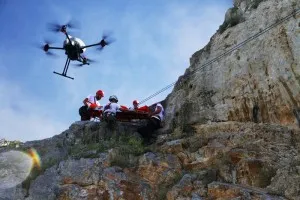Search and rescue (SAR) operations are a vital part of emergency response services that help in saving lives and property during times of crisis. SAR teams are trained to navigate through rough terrain and challenging environments to reach and rescue individuals in distress. However, SAR operations can be challenging and dangerous, particularly in situations where access is difficult, such as during natural disasters, forest fires, or mountain rescues. Drones have emerged as a valuable tool for SAR operations, providing quick and efficient support to rescue teams in locating and rescuing individuals in distress.
In this article, we will discuss the role of drones in SAR operations and how they have revolutionized the way emergency response teams function.
Advantages of drones in SAR operations
Drones have several advantages that make them ideal for SAR operations. These advantages include:
Quick deployment: Drones can be launched and flown within minutes, making them ideal for situations where quick deployment is critical.

Aerial perspective: Drones provide a unique aerial perspective that can help SAR teams in identifying and locating individuals in distress. They can cover a large area quickly, which can save precious time and resources.
Real-time data: Drones can transmit real-time data to the SAR teams, providing them with crucial information such as the location of the victim, the terrain, and the weather conditions.
Cost-effective: Drones are cost-effective compared to traditional search and rescue methods, such as helicopters or ground-based search teams.
Safe: Drones can reduce the risk to SAR teams during the search operation, particularly in hazardous or difficult to reach areas.
Applications of drones in SAR operations
Drones have numerous applications in SAR operations. Some of the most common applications include:
Search operations: Drones are ideal for search operations in areas where access is limited or dangerous. They can cover large areas quickly and can be equipped with cameras and other sensors to detect individuals in distress.
Disaster management: Drones can be used to assess the damage caused by natural disasters such as earthquakes, floods, and hurricanes. They can help in identifying areas that require immediate attention and provide valuable data to the rescue teams.
Wildfire management: Drones can be used to monitor and assess wildfires. They can provide real-time data on the extent of the fire, its direction, and the weather conditions, helping the firefighting teams to make informed decisions.
Mountain rescues: Drones can be used to locate and rescue individuals trapped in difficult to reach areas such as mountain slopes or cliffs. They can provide real-time data on the terrain and weather conditions, which can help the rescue teams to plan their operation more effectively.
Water rescues: Drones can be used in water rescues to locate and assist individuals who are stranded in the water or need immediate medical attention.
Equipment and sensors used in drones for SAR operations
Drones used for SAR operations are typically equipped with cameras, sensors, and other equipment that help in locating individuals in distress. Some of the commonly used equipment includes:
Thermal cameras: Thermal cameras can detect heat signatures and are ideal for locating individuals in low-light conditions, such as at night or in areas covered by dense vegetation.

GPS: GPS systems are essential for navigation and tracking during SAR operations. They can help in locating the drone’s position and the victim’s location.
Sonar: Sonar systems can be used in water rescues to detect individuals who are submerged or trapped underwater.
Two-way radios: Two-way radios are essential for communication between the drone operator and the SAR team on the ground. They can help in coordinating the search operation more effectively.
First aid kits: Some drones used in SAR operations may be equipped with first aid kits that can be used to provide immediate medical assistance to the victim.
Challenges faced in the use of drones for SAR operations
While drones have many advantages in SAR operations, they also face some challenges. Some of the common challenges include:
Limited battery life: Drones have limited battery life, which can limit their range and flight time during SAR operations.
Weather conditions: Drones may not be able to operate in adverse weather conditions such as high winds, heavy rain, or snow.
Technical issues: Drones may face technical issues during flight, which can cause them to crash or malfunction, particularly in challenging environments.
Privacy concerns: Drones may invade privacy during SAR operations, particularly in urban areas.
Regulatory challenges: Drones are subject to regulations by aviation authorities, which may limit their use in SAR operations.
Conclusion
Drones have revolutionized the way SAR operations are conducted. They provide quick and efficient support to rescue teams, saving precious time and resources in locating and rescuing individuals in distress. However, drones also face several challenges that need to be addressed to ensure their safe and effective use in SAR operations. With continued advancements in drone technology and regulatory frameworks, drones will continue to play a vital role in SAR operations, ultimately saving lives and property during times of crisis.










